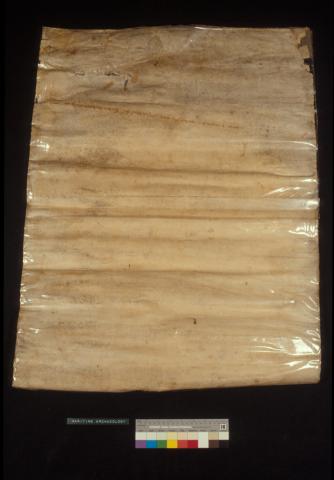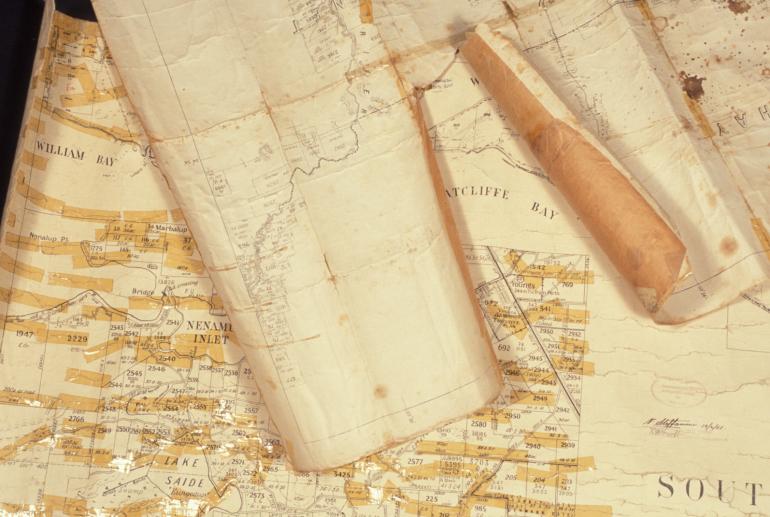Deterioration
Paper is prone to attack and subsequent degradation by chemical, biological and environmental agents. Deterioration may be caused by:
- the presence of potentially damaging chemicals within the paper;
- exposure to external pollutants;
- environmental factors such as light and relative humidity;
- biological attack by moulds, insects and rodents; and
- inappropriate intervention or lack of care by those responsible for collections.
High levels of acidity in paper may be brought about by the presence of material introduced both during and after processing. These materials include alum or rosin sizing agents, high lignin pulp material, coatings and certain inks such as iron gall ink. Acidic substances attack the long cellulose chains, causing them to break into smaller units. A more brittle paper, or one containing holes, may result. Absorption and chemical reaction with oxides of nitrogen and sulphur from the air, combined with the natural ageing of paper components, may also contribute to increased acidity levels in paper.
Chemical processes can affect the appearance as well as the mechanical structure of paper. Oxidation of cellulose, catalysed by iron or copper impurities or by the presence of atmospheric ozone produced as a by-product of the photocopying process, may lead to the development of foxing stains similar to those produced by moulds. High relative humidity levels enhance this type of degradation.
Light-induced photochemical degradation, initiated by exposure to both white light and UV radiation may either yellow or bleach paper. Heating of paper, caused by overexposure to light further accelerates deterioration processes.
Dust and dirt may lead to a combination of chemical, biological and mechanical damage. The abrasive nature of dirt particles may cause physical damage to fibres. Dirt particles also act as nucleation centres, encouraging condensation, chemical attack and mould development.
Mould formation is enhanced by high relative humidity. Moulds which develop on paper cause stains known as foxing. These stains are usually brown in colour and are especially disfiguring to works of art on paper (Figure 1). Fluctuating relative humidity levels can cause physical damage to paper. Under conditions of high relative humidity swelling of paper may lead to cockling, while low relative humidity can result in paper becoming brittle.
Figure 1: Map – Shark Bay. Laminated in self-adhesive contact. This shows staining and mould as well as folds and creases.
Insects such as silverfish, cockroaches, flies and book lice and rodents such as rats and mice cause physical damage by feeding on paper. Additional damage is caused by their excreta.
Do not underestimate the influence that careless handling or treatment can have on the deterioration processes that affect paper. Some examples of this type of damage include:
- the application of adhesive tapes to paper;
- the use of metal paper clips or pins;
- the inappropriate use of backing and other materials;
- poor quality framing or mounting;
- rough and inappropriate handling; and
- deficient storage conditions
Do not use adhesive tape as a means of repair. Inevitably the adhesive tape fails, leaving behind a yellow stain that is very difficult, if not impossible, to remove (Figure 2).
Figure 2: Maps showing damage from adhesive tape and acidic backings.
Do not use pressure-sensitive or gummed tapes, sold as archival repair tapes, without first consulting a conservator.
Metal paper clips and pins are prone to rusting, cause indentations in the paper and have sharp ends with the potential to tear paper. Pins leave holes.
Acidic mount boards and inappropriate backing (such as plywood, cardboard, chipboard and straw boards) can destroy or discolour the paper objects they were meant to support. They can also cause mat burn, the brown line that imprints itself into the artwork along the window mount.
Poor framing, in which there is direct contact between the work of art and the glass or acrylic, may lead to the transfer of part of the image to the glass or acrylic. An obvious loss of part of the original image is the result.
Rough and inappropriate handling can cause tears and creasing. Stains such as fingerprints will deface paper and may be irreversible.
Deficient storage such as in damp cellars or attics, inappropriate shelving and cabinets or acidic boxes can all permanently harm a collection of paper-based objects.














